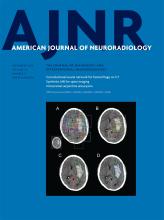Abstract
BACKGROUND: The implantation of flow-diverter stents for the treatment of ruptured intracranial aneurysms required further investigation.
PURPOSE: Our aim was to analyze the outcomes after flow diversion of ruptured intracranial aneurysms.
DATA SOURCES: A systematic search of 3 databases was performed for studies published from 2006 to 2018.
STUDY SELECTION: According to the Preferred Reporting Items for Systematic Reviews and Meta-Analyses guidelines, we included studies (from 2010 to 2018) reporting acutely ruptured intracranial aneurysms treated with flow diversion.
DATA ANALYSIS: Random-effects meta-analysis was used to pool the following: aneurysm occlusion rate, complications, rebleeding, and factors influencing the studied outcomes.
DATA SYNTHESIS: We included 20 studies evaluating 223 patients with acutely ruptured intracranial aneurysms treated with flow-diverter stents. Immediate angiographic occlusion was obtained in 32% (29/86; 95% CI, 15.4%–48%; I2 = 79.6%) of aneurysms, whereas long-term complete/near-complete aneurysm occlusion was 88.9% (162/189; 95% CI, 84%–93.5%; I2 = 20.9%) (mean radiologic follow-up of 9.6 months). The treatment-related complication rate was 17.8% (42/223; 95% CI, 11%–24%; I2 = 52.6%). Complications were higher in the posterior circulation (16/72 = 27%; 95% CI, 14%–40%; I2 = 66% versus 18/149 = 11.7%; 95% CI, 7%–16%; I2 = 0%) (P = .004) and after treatment with multiple stents (14/52 = 26%; 95% CI, 14%–45%; I2 = 59%) compared with a single stent (20/141 = 10%; 95% CI, 5%–15%; I2 = 0%) (P = .004). Aneurysm rebleeding after treatment was 4% (5/223; 95% CI, 1.8%–7%; I2 = 0%) and was higher in the first 72 hours.
LIMITATIONS: Small and retrospective series.
CONCLUSIONS: Flow-diversion treatment of ruptured intracranial aneurysms yields a high rate of long-term angiographic occlusion with a relatively low rate of aneurysm rebleeding. However, treatment is associated with a complication rate of 18%. When coiling or microsurgical clipping are not feasible strategies, anterior circulation ruptured aneurysms can be effectively treated with a flow-diversion technique, minimizing the number of stents deployed. Given the 27% rate of complications, flow diversion for ruptured posterior circulation aneurysms should be considered only in selected cases not amenable to other treatments.
ABBREVIATIONS:
- ASA
- acetylsalicylic acid
- CP
- clopidogrel
- IQR
- interquartile range
- PRISMA
- Preferred Reporting Items for Systematic Reviews and Meta-Analyses
- © 2018 by American Journal of Neuroradiology












